A Cornucopia of Beer
Brewers Are Rediscovering Fruit
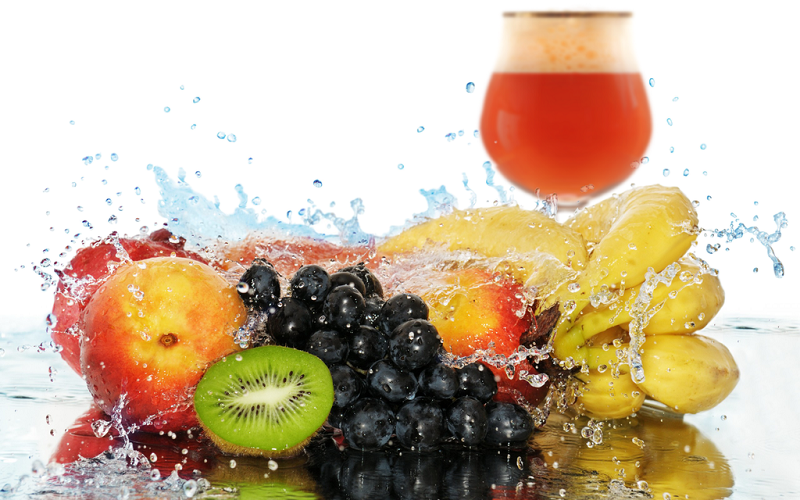
For a brief but unfortunate time in the history of beer, “fruit beer” was synonymous with “bad beer.” This was the time when brewers were adding fruit to beers to make them sweet and syrupy and marketed them to people who didn’t much like beer.
In truth, fruit has been used in beer for a very long time and usually enhanced the beer, rather than detracted from it. The use of fruit in beer predates the use of hops. Molecular analysis of drinking vessels recovered by archaeologists shows that many ancient beers contained fruit of some kind. These are often the basis of Dogfish Head Brewing’s line of ancient ales. Similarly, Williams Bros. Brewing of Alloa, Scotland, reproduces ancient Scottish ales made with gooseberries and elderberries. And of course, fruits, especially cherries and raspberries, have been used in lambics for as long as anyone knows. Where hops have been used in beer only since the 9th or 10th centuries, the use of fruit in beer goes back millennia.
Brewers around the globe are now rediscovering fruit, not as an ingredient to mask the flavor of their beer, but as an ingredient to enhance the flavor of their beer. Not only are they turning to common fruits such as apples, peaches and cherries, but there also seems to be an arms race to see who can discover the most unusual fruit to put into their latest brew.
Used skillfully, fruit can be used to add sweetness or acidity to beer, provide aroma, increase alcohol content, enhance its color or provide wild bacteria or yeast. Some breweries carefully select their fruit and design a beer around it. Some brewers just add fruit that they think will work well to a beer they already brew, tasting the beer along the brewing and maturation process, trying to control the serendipitous results through careful blending.
Most breweries using fruit make only minor adjustments to the brewing process, reducing the gravity of the wort to compensate for the sugars in the fruit or tweaking pH levels. Still, brewing with fruit is not easy. The fruit itself often requires hours of preparation, peeling, pitting, chopping, slicing or pureeing that often must occur early in the morning on brew day, since preparation beforehand would allow fruit to spoil or oxidize. Then, there is the big task of cleaning up afterward. For that reason, some brewers have turned to using syrups or extracts, but the emphasis is always on making the beer better.
Here’s a look at some of the fruits inspiring brewers and drinkers.
Peach
 Peaches are stone fruit featuring a velvetlike fuzz on their skin and either yellow or white flesh inside. White-fleshed peaches tend to be sweeter, while yellow-fleshed peaches tend to have more acidity. Native to northwest China, peaches were brought to America by Spanish explorers in the 16th century. Today, peaches are second only to apples in American fruit crops. Peach orchards are concentrated in the Southern states, although there is significant production in Michigan, Colorado and California. Logsdon Farmhouse Ales of Hood River, OR, however, gets the peaches used in its Peche ’n Brett from Columbia Blossom Organic Orchards, a mere 20-minute drive from the brewery to Mosier. “We brew our Seizoen Bretta, which is the base beer for the Peche ’n Brett, and in drinking it, it seemed to be a natural mix by adding peaches,” says brewmaster and farmer David Logsdon. “The fruit provides added acidity to the beer, and it raises the alcohol level of the beer from 8 percent to 10 percent” Logsdon uses Diamond Princess and John Henry peaches, both yellow-fleshed varieties.
Peaches are stone fruit featuring a velvetlike fuzz on their skin and either yellow or white flesh inside. White-fleshed peaches tend to be sweeter, while yellow-fleshed peaches tend to have more acidity. Native to northwest China, peaches were brought to America by Spanish explorers in the 16th century. Today, peaches are second only to apples in American fruit crops. Peach orchards are concentrated in the Southern states, although there is significant production in Michigan, Colorado and California. Logsdon Farmhouse Ales of Hood River, OR, however, gets the peaches used in its Peche ’n Brett from Columbia Blossom Organic Orchards, a mere 20-minute drive from the brewery to Mosier. “We brew our Seizoen Bretta, which is the base beer for the Peche ’n Brett, and in drinking it, it seemed to be a natural mix by adding peaches,” says brewmaster and farmer David Logsdon. “The fruit provides added acidity to the beer, and it raises the alcohol level of the beer from 8 percent to 10 percent” Logsdon uses Diamond Princess and John Henry peaches, both yellow-fleshed varieties.
The beer is a blend of barrel-aged and fresh beer with raw, pitted peaches (about a pound and a half of peaches per gallon of beer) added to spark a secondary fermentation lasting two to three months. The peaches are unprocessed when pitched into the brew, so naturally occurring yeast and bacteria in the fruit provide some additional complexity. Peche ’n Brett won a gold medal at the 2012 World Beer Cup in the Fruit Beer category and a silver medal at the 2014 Great America Beer Festival for American-Style Brett Beer.
Breadfruit
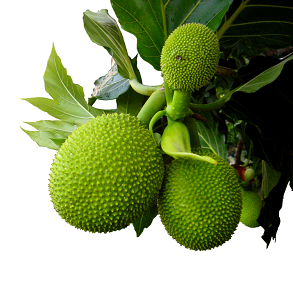 Many people have never heard of breadfruit, but as Garrett Marrero, founder of Maui Brewing Co., explains, “Breadfruit has been a staple of Polynesian and south Pacific diets for centuries. We wanted to use the breadfruit to highlight an amazing local resource.” Breadfruit, which is known as ulu in Hawaiian, is a relative of the jackfruit. Each is about the size of a grapefruit, but with a rough, spiky skin. The exterior is green while the flesh is white. Breadfruit’s flavor has been described as similar to bread or potatoes, although it gets sweeter as it ripens. In Maui Brewing’s beer (a collaboration with Dogfish Head, named, appropriately enough, Liquid Breadfruit) Marrero describes the beer as providing tropical flavors and aromas, including melon, Juicy Fruit gum (which is said to resemble jackfruit) and citrus. “The fruit had to be prepared, and that was the biggest task. We rough-chopped [3,000 pounds of] the ripe breadfruit. We also toasted and blended papaya seeds. The fruit was added to the mash and kettle while the papaya seeds were literally dipped into the kettle for a short time,” Marrero says. The result is an imperial golden ale weighing in at 8.2%, with a portion of the alcohol coming from the fermentable sugars provided by the fruit. The toasted papaya seeds provide a peppercornlike bitterness to balance the sweetness of the fruit and the alcohol.
Many people have never heard of breadfruit, but as Garrett Marrero, founder of Maui Brewing Co., explains, “Breadfruit has been a staple of Polynesian and south Pacific diets for centuries. We wanted to use the breadfruit to highlight an amazing local resource.” Breadfruit, which is known as ulu in Hawaiian, is a relative of the jackfruit. Each is about the size of a grapefruit, but with a rough, spiky skin. The exterior is green while the flesh is white. Breadfruit’s flavor has been described as similar to bread or potatoes, although it gets sweeter as it ripens. In Maui Brewing’s beer (a collaboration with Dogfish Head, named, appropriately enough, Liquid Breadfruit) Marrero describes the beer as providing tropical flavors and aromas, including melon, Juicy Fruit gum (which is said to resemble jackfruit) and citrus. “The fruit had to be prepared, and that was the biggest task. We rough-chopped [3,000 pounds of] the ripe breadfruit. We also toasted and blended papaya seeds. The fruit was added to the mash and kettle while the papaya seeds were literally dipped into the kettle for a short time,” Marrero says. The result is an imperial golden ale weighing in at 8.2%, with a portion of the alcohol coming from the fermentable sugars provided by the fruit. The toasted papaya seeds provide a peppercornlike bitterness to balance the sweetness of the fruit and the alcohol.
Fig
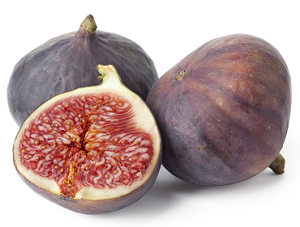 Figs are the fruit of a ficus tree. Each fruit is pear-shaped, but a little larger than a silver dollar. There is some white rind surrounding the red, seed-filled flesh inside. Figs are almost always consumed in some processed form, either dried or as a jam, or, of course, as the filling in a cookie. Figs are very nutritious, being rich in a number of vitamins and minerals, being high in fiber and containing antioxidants. The same can be said of beer, so perhaps figs and beer are a natural combination. Ron Gansberg, brewmaster of Cascade Brewing of Portland, OR, says, “We very much looked forward to using white figs in our Northwest-style sour ale. Figaro is made from a strong blond [base beer]. We were interested in the contribution of figs to the mouthfeel of this beer.” There are hundreds of varieties of figs. White figs (which are actually green or yellow in color) are less sweet than other varieties, though all figs are quite sweet. Cascade cuts the figs into small slices and adds them directly to the beer in barrels, in this case French Chardonnay barrels, with some lemon peel. The sweetness of the figs helps to counter the sour beer, though Figaro remains decidedly sour.
Figs are the fruit of a ficus tree. Each fruit is pear-shaped, but a little larger than a silver dollar. There is some white rind surrounding the red, seed-filled flesh inside. Figs are almost always consumed in some processed form, either dried or as a jam, or, of course, as the filling in a cookie. Figs are very nutritious, being rich in a number of vitamins and minerals, being high in fiber and containing antioxidants. The same can be said of beer, so perhaps figs and beer are a natural combination. Ron Gansberg, brewmaster of Cascade Brewing of Portland, OR, says, “We very much looked forward to using white figs in our Northwest-style sour ale. Figaro is made from a strong blond [base beer]. We were interested in the contribution of figs to the mouthfeel of this beer.” There are hundreds of varieties of figs. White figs (which are actually green or yellow in color) are less sweet than other varieties, though all figs are quite sweet. Cascade cuts the figs into small slices and adds them directly to the beer in barrels, in this case French Chardonnay barrels, with some lemon peel. The sweetness of the figs helps to counter the sour beer, though Figaro remains decidedly sour.
Yuzu
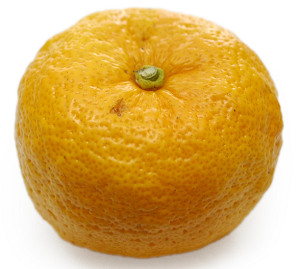 New Belgium Brewing is always looking for something interesting for its Lips of Faith series of beers. Enter yuzu, an Asian citrus fruit. It is smaller than a grapefruit and has a yellow/green skin. Yuzu is tart and slightly bitter, though it has generally less intense flavors than grapefruit and is sweeter. Yuzu is so aromatic, it is sometimes used in making fragrances. Peter Bouckaert, brewmaster of New Belgium and winner of the 2013 Russell Schehrer Award for Innovation in Brewing, explains the thought process behind adding yuzu to beer: “We used it in an imperial Berliner weisse. The simple sourness from that beer got richer with the fruitiness of the yuzu, and it gave it the yuzu aroma on top of it. … Berliner weisses are simply lactic sour. This is a sweet/sour acid that you cannot smell. … The yuzu filled in the aroma of the beer, and the sourness of the yuzu enhanced the complexity of this sour beer.” In New Belgium’s beer, the fruit is juiced and added at the end of the boil so that the sugars are fermented to increase alcohol content and reduce sweetness, emphasizing the sourness of the beer and the fruit.
New Belgium Brewing is always looking for something interesting for its Lips of Faith series of beers. Enter yuzu, an Asian citrus fruit. It is smaller than a grapefruit and has a yellow/green skin. Yuzu is tart and slightly bitter, though it has generally less intense flavors than grapefruit and is sweeter. Yuzu is so aromatic, it is sometimes used in making fragrances. Peter Bouckaert, brewmaster of New Belgium and winner of the 2013 Russell Schehrer Award for Innovation in Brewing, explains the thought process behind adding yuzu to beer: “We used it in an imperial Berliner weisse. The simple sourness from that beer got richer with the fruitiness of the yuzu, and it gave it the yuzu aroma on top of it. … Berliner weisses are simply lactic sour. This is a sweet/sour acid that you cannot smell. … The yuzu filled in the aroma of the beer, and the sourness of the yuzu enhanced the complexity of this sour beer.” In New Belgium’s beer, the fruit is juiced and added at the end of the boil so that the sugars are fermented to increase alcohol content and reduce sweetness, emphasizing the sourness of the beer and the fruit.
Cherry
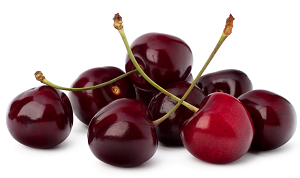 There are many types of cherries, but they can be broadly categorized as either sweet or sour. When used in beer, cherries need to be pitted, because the seed contains cyanide compounds. Many fruit pits do, but given the ratio of fruit flesh to seed, the issue is more acute in cherries. Cherries have a short season, so beers using fresh cherries can only be brewed once per year. Such is the case of Wisconsin Belgian Red, made by New Glarus Brewing of Wisconsin with sour Montmorency cherries from Door County, WI, accenting the base beer, which is a sour brown ale. New Glarus brewmaster Daniel Carey was inspired to brew Wisconsin Belgian Red after trying Lindemans and Liefmans beers in Belgium when visiting in 1986. “I went about trying to brew a beer like this for six years,” he says. “At that time, there was nothing like it being brewed in America.” No brewers yeast is added to the beer. Instead, the base beer is allowed to gather wild yeast while sitting in a coolship under a wooden roof, which contains microflora. The beer is then pumped into old wine foeders (large wood barrels), which contribute additional acidifying organisms, and the pitted cherries are added. The cherries themselves contain wild yeast and bacteria, contributing even more complexity to the beer. On most beer rating websites, Wisconsin Belgian Red now outranks the beers it was intended to emulate.
There are many types of cherries, but they can be broadly categorized as either sweet or sour. When used in beer, cherries need to be pitted, because the seed contains cyanide compounds. Many fruit pits do, but given the ratio of fruit flesh to seed, the issue is more acute in cherries. Cherries have a short season, so beers using fresh cherries can only be brewed once per year. Such is the case of Wisconsin Belgian Red, made by New Glarus Brewing of Wisconsin with sour Montmorency cherries from Door County, WI, accenting the base beer, which is a sour brown ale. New Glarus brewmaster Daniel Carey was inspired to brew Wisconsin Belgian Red after trying Lindemans and Liefmans beers in Belgium when visiting in 1986. “I went about trying to brew a beer like this for six years,” he says. “At that time, there was nothing like it being brewed in America.” No brewers yeast is added to the beer. Instead, the base beer is allowed to gather wild yeast while sitting in a coolship under a wooden roof, which contains microflora. The beer is then pumped into old wine foeders (large wood barrels), which contribute additional acidifying organisms, and the pitted cherries are added. The cherries themselves contain wild yeast and bacteria, contributing even more complexity to the beer. On most beer rating websites, Wisconsin Belgian Red now outranks the beers it was intended to emulate.
Apricot
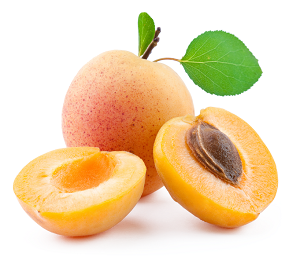 Apricots have a similar appearance to peaches and are, like peaches, classified as stone fruit. But apricots are much smaller and have flesh that is less juicy. About 90 percent of apricots in the United States come from California, where the fruit has been grown since the late 18th century, having been brought to America by Spanish missionaries. Apricots are rich in vitamins A and C, are a significant source of potassium and are high in fiber. Some say that apricots are one of the most nutritious fruits you can eat. Apricots have a flavor that is often used as a descriptor for hops, which makes them a natural choice for brewing. Dogfish Head Brewing of Delaware uses them in its Aprihop. “We wanted to brew a fruit beer for people who don’t like fruit beers,” says Justin Williams, a Dogfish Head spokesman. “It’s more hop-forward, and the fruit component plays a supporting role. We add apricot juice to the hot side [before the wort is chilled] after the heat is turned off on the kettle.” The sugars from the fruit are fermented, so the beer is not sweet, allowing the accompanying Amarillo hops to shine as much as the apricot. In fact, like Dogfish Head’s famous “Minute” IPAs, Aprihop is continuously hopped, where a small amount of hops is added every minute during the kettle boil.
Apricots have a similar appearance to peaches and are, like peaches, classified as stone fruit. But apricots are much smaller and have flesh that is less juicy. About 90 percent of apricots in the United States come from California, where the fruit has been grown since the late 18th century, having been brought to America by Spanish missionaries. Apricots are rich in vitamins A and C, are a significant source of potassium and are high in fiber. Some say that apricots are one of the most nutritious fruits you can eat. Apricots have a flavor that is often used as a descriptor for hops, which makes them a natural choice for brewing. Dogfish Head Brewing of Delaware uses them in its Aprihop. “We wanted to brew a fruit beer for people who don’t like fruit beers,” says Justin Williams, a Dogfish Head spokesman. “It’s more hop-forward, and the fruit component plays a supporting role. We add apricot juice to the hot side [before the wort is chilled] after the heat is turned off on the kettle.” The sugars from the fruit are fermented, so the beer is not sweet, allowing the accompanying Amarillo hops to shine as much as the apricot. In fact, like Dogfish Head’s famous “Minute” IPAs, Aprihop is continuously hopped, where a small amount of hops is added every minute during the kettle boil.
Tangerine
Tangerines, also known as mandarin oranges, are similar to clementines, which are hybrids of tangerines and Seville oranges. Tangerines are typically sweeter than oranges with thin, easy-to-peel rinds making them very popular as a snacking fruit. One tangerine provides 31 percent of the recommended daily does of vitamin C (more than an orange). They are also a good source of antioxidants and fiber. Lost Coast Brewery of Eureka, CA, thought they would be perfect for its Tangerine Wheat. “Lemon has traditionally been served with wheat beers,” says Catherine Coontz, marketing representative of Lost Coast, “yet tangerine is a lively sweet citrus fruit that we thought would energize the palate and enhance the flavor of that style of beer. Citrus is the perfect complement to a wheat-based beer, as it helps to cut the breadlike qualities of the wheat.” The base beer is made with a lower pH to provide tartness and accentuate the fruit. Tangerine essence is added at the time of packaging so that the aromas and flavors are fresh and unaltered by brewing or fermentation.
Watermelon
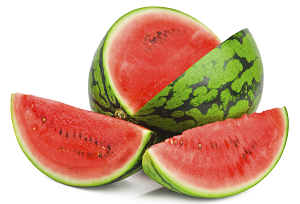 Watermelon, not surprisingly, contains a lot of water; by weight, watermelon is over 90 percent water. It has a light sweetness and, combined with its water content, is a refreshing fruit to eat on hot summer days. This makes watermelon a great ingredient for beer, which often shares a similar refreshingness. “Beer guys who like IPAs and imperial stouts look down their noses on fruit beers,” says Shaun O’Sullivan, brewmaster at 21st Amendment Brewery, “but my partner Nico [Freccia] had a homebrew recipe [for a watermelon wheat beer] so we knew we could change some minds.” Because watermelon is mostly water, 21st Amendment does not worry about what variety of watermelon it uses in its now famous Hell or High Watermelon Wheat Beer. When O’Sullivan and Freccia first brewed it, they would simply start brewing the beer each year to coincide with the beginning of the watermelon harvest. As the year moved on, they would get different watermelon from different regions with later seasons. As the popularity of the beer has grown from 120 barrels sold in 2001 to almost 20,000 barrels this year, 21st Amendment has had to switch to watermelon juice. Although O’Sullivan will not say when the watermelon is added to the brew, he will say that the small amount of sugars in it is allowed to ferment. He also confirms that the base beer needs to have an increased malt bill to accommodate all of the water contributed by the fruit. “The beer guys will whisper in my ear that they really like this beer,” says O’Sullivan. “I have to assure them they’ll be OK.” Fruit beer has come full circle and re-earned its place in the brewmasters’ toolbox.
Watermelon, not surprisingly, contains a lot of water; by weight, watermelon is over 90 percent water. It has a light sweetness and, combined with its water content, is a refreshing fruit to eat on hot summer days. This makes watermelon a great ingredient for beer, which often shares a similar refreshingness. “Beer guys who like IPAs and imperial stouts look down their noses on fruit beers,” says Shaun O’Sullivan, brewmaster at 21st Amendment Brewery, “but my partner Nico [Freccia] had a homebrew recipe [for a watermelon wheat beer] so we knew we could change some minds.” Because watermelon is mostly water, 21st Amendment does not worry about what variety of watermelon it uses in its now famous Hell or High Watermelon Wheat Beer. When O’Sullivan and Freccia first brewed it, they would simply start brewing the beer each year to coincide with the beginning of the watermelon harvest. As the year moved on, they would get different watermelon from different regions with later seasons. As the popularity of the beer has grown from 120 barrels sold in 2001 to almost 20,000 barrels this year, 21st Amendment has had to switch to watermelon juice. Although O’Sullivan will not say when the watermelon is added to the brew, he will say that the small amount of sugars in it is allowed to ferment. He also confirms that the base beer needs to have an increased malt bill to accommodate all of the water contributed by the fruit. “The beer guys will whisper in my ear that they really like this beer,” says O’Sullivan. “I have to assure them they’ll be OK.” Fruit beer has come full circle and re-earned its place in the brewmasters’ toolbox.
Check out this list of award-winning fruit beers.
The following fruit beers were reviewed by John Holl, Terry Lozoff, Lee Movic and Kelsey Roth on Dec. 5, 2014, at the Craft Beer Cellar in Belmont, MA.

Slumbrew Happy Sol
ABV: 5.5Tasting Notes: Burnt orange in color with aromas of orange, biscuit, wheat and clove. That last ingredient comes through with a pop. Brewed with blood orange juice, this hefeweizen has a tangy bite, like pith. Ultimately refreshing, it finishes dry.

Stiegl Radler
ABV: 2.5Tasting Notes: With a passionate following this is essentially an alcoholic grapefruit soda. It’s hazy yellow with the overwhelming aroma of juicy grapefruit. The taste reveals some tart lemon. It’s refreshing and a beverage that can be easily satisfying for those with a sweet tooth. The 2.5% ABV is a major selling point for some. Others use it as a mixer for gin.

Samuel Smith's Organic Strawberry Ale
ABV: 5.2Tasting Notes: This strawberry-infused ale is burnt orange in color, and has aromas and flavors of coconut, rhubarb,candied strawberries,shortcake, and butter cookies, there’s no fresh fruit flavor, but rather dried flavored marshmallows, like those in cereal. Melon appears on the finish. It’s for the sugar lovin’ beer drinker.
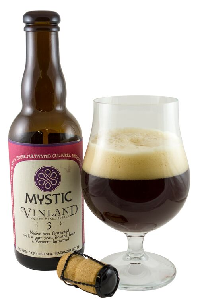
Mystic Brewing Co. Vinland Three
ABV: 6Tasting Notes: Dark brown with garnet highlights, this anniversary ale was brewed with three yeast cultures. Aromas of wheat, toast, toffee and ripened fruit. The flavor yields blackberry, raspberry preserves and rye spice. Robustly carbonated, it finishes with a tart snap.
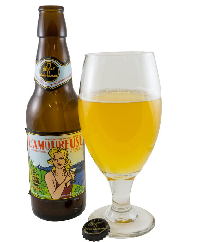
Brasserie Trois Dames L’amoureuse
ABV: 8Tasting Notes: This Belgian strong pale ale, brewed with grapes, is reminiscent of a dry wine, but aromas of lemon and honey are more dominant. Wonderfully complex with a mild tart character and a welcome lack of sugar. As it warms, grape must becomes more present, and the tannins allow it to finish dry.
Don Tse
Don Tse is a freelance beer and whisky writer from Calgary, Alberta. He occasionally gets some of his recommended daily intake of fruit in the form of beer.

Leave a Reply